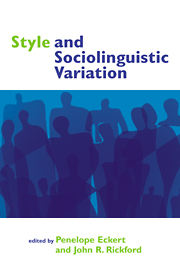Book contents
- Frontmatter
- Contents
- List of figures
- List of tables
- List of contributors
- Acknowledgments
- Introduction: John R. Rickford and Penelope Eckert
- Part I Anthropological approaches
- Part 2 Attention paid to speech
- 5 The anatomy of style-shifting
- 6 A dissection of style-shifting
- 7 Style and social meaning
- 8 Zeroing in on multifunctionality and style
- Part 3 Audience design and self-identification
- Part 4 Functionally motivated situational variation
- References
- Index
8 - Zeroing in on multifunctionality and style
Published online by Cambridge University Press: 07 December 2009
- Frontmatter
- Contents
- List of figures
- List of tables
- List of contributors
- Acknowledgments
- Introduction: John R. Rickford and Penelope Eckert
- Part I Anthropological approaches
- Part 2 Attention paid to speech
- 5 The anatomy of style-shifting
- 6 A dissection of style-shifting
- 7 Style and social meaning
- 8 Zeroing in on multifunctionality and style
- Part 3 Audience design and self-identification
- Part 4 Functionally motivated situational variation
- References
- Index
Summary
Introduction
To a historical linguist like myself who works on grammaticalization and discourse analysis, William Labov's work has for several decades held out the prospect of developing a framework for a theory of language change that can illuminate the fundamental problems of conceptualizing and operationalizing differences between innovation and spread, whether within the linguistic system or within the community, and between structure and use (see especially the groundbreaking work in Weinreich, Labov, and Herzog 1968 and Labov 1974). That only very little work has been done combining the insights of grammaticalization and sociolinguistics is regrettable. However, the projected volume 3 of Labov's Principles of Linguistic Change promises to address grammaticalization issues, while Bruyn (1995) and Baker and Syea (1996) directly take on the issues of the extent to which grammaticalization theory and the sociolinguistics of contact languages can inform each other.
Grammaticalization theory (see e.g. Heine and Reh 1984, Heine, Claudi, and Hönnemeyer 1991, Traugott and Heine 1991, Hopper and Traugott 1993, Pagliuca 1994, Lehmann 1995[1982]) has in the main not been directly concerned with “pure” phonological or semantic change (in so far as these exist, e.g. the Great Vowel Shift or recent changes in the meaning of gay). Like much “mainstream” historical linguistics (e.g. Lightfoot 1991, Roberts 1992/93), it privileges change in the individual over change in the community, and thus has not focused on social factors. But unlike much mainstream linguistics it focuses on the intersection of “internal” grammar (structure) and “external” grammar (use), and insists on gradience and process rather than product.
- Type
- Chapter
- Information
- Style and Sociolinguistic Variation , pp. 127 - 136Publisher: Cambridge University PressPrint publication year: 2002
- 2
- Cited by



